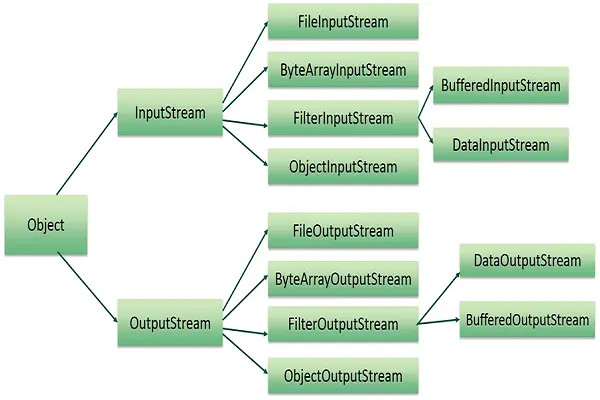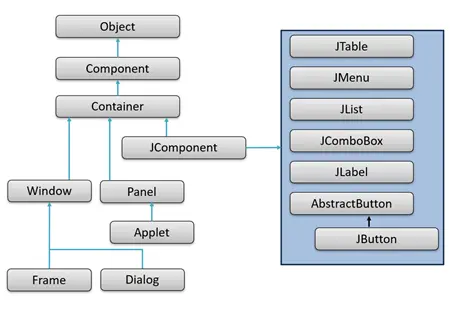What is File?
A file can refer to various resources such as a disk file, terminal, or printer. Files stored on secondary storage devices are known as physical files.
To process a file within a program, a logical file must be created in RAM. This logical file is essentially an object of a file data type. Java's I/O system provides a consistent interface for file operations, regardless of the underlying device.
A stream is generally a sequence of data and serves as an abstraction between the programmer and the actual device (file). Streams are categorized into two types:
- Text stream: A sequence of characters.
- Binary stream: A sequence of bytes with a direct one-to-one mapping to the external device—no character translation occurs.
File input output in Java
To work with files in Java, the java.io package must be imported using:
import java.io.*;
Java allows reading from input devices like the keyboard and files using various I/O classes:
Reading Input
- BufferedReader: Reads characters from an input stream efficiently.
- FileReader: Reads characters from a file.
- InputStreamReader: Converts byte streams to character streams using a specified charset.
Example:
BufferedReader br = new BufferedReader(new FileReader("b.txt"));
BufferedReader br = new BufferedReader(new InputStreamReader(System.in));
Writing Output
- BufferedWriter: Writes characters to an output stream efficiently.
- FileWriter: Writes characters to a file and is often used with BufferedWriter.
- OutputStreamWriter: Converts character streams to byte streams using a specified charset.
Java File I/O Class Hierarchy and Relationships
public class FileInputStreamextendsInputStreampublic class FileReaderextendsInputStreamReaderpublic class FileOutputStreamextendsOutputStreampublic class FileWriterextendsOutputStreamWriterpublic class FileextendsObjectpublic abstract class InputStreamextendsObjectpublic abstract class OutputStreamextendsObjectpublic class BufferedReaderextendsReaderpublic class BufferedWriterextendsWriterpublic class DataInputStreamextendsFilterInputStreamimplementsDataInputpublic class DataOutputStreamextendsFilterOutputStreamimplementsDataOutput
File and FileDialog Classes
The File class is part of the java.io.* package. It represents
an abstract view of file and directory pathnames in a system-independent manner.
Constructor:
File(String pathname)Creates a new File instance by converting the given pathname string into an abstract pathname.
Common Methods:
boolean canRead(): Checks if the file is readable.boolean canWrite(): Checks if the file is writable.String getName(): Returns the name of the file or directory.
FileDialog Class
The FileDialog class, from the java.awt package, provides a platform-specific dialog that allows the user to select files for reading or writing.
Static Constants:
FileDialog.LOAD: Used to open a file (read mode).FileDialog.SAVE: Used to save a file (write mode).
Common Constructor:
FileDialog(Frame parent, String title, int mode)- Frame parent: The parent window of the dialog.
- String title: The title of the dialog window.
- int mode: Indicates whether the dialog is for loading or saving a file.
The FileDialog class can be used in combination with other I/O classes such as:
FileWriter,FileReaderInputStreamReader,OutputStreamWriterBufferedReader,BufferedWriter
Common Methods:
String getDirectory(): Returns the selected directory.String getFile(): Returns the selected file.
Example:→Creating new File with Java:
Source code
import java.io.File;
public class OneCreateFile {
public OneCreateFile() {
createFile(); //Calling createFile()
}
public static void main(String[] args) {
OneCreateFile cr = new OneCreateFile();
}
public void createFile()
{
try {
File file = new File("oop.txt");
if (file.createNewFile()) {
System.out.println("File Created!");
System.out.println("Created File Name:"+file.getName());
System.out.println("Created File can Execute?:"+file.canExecute());
System.out.println("Created File can Write?:"+file.canWrite());
} else {
System.out.println("File aleardy Created!");
System.out.println("File Information");
System.out.println("Absolute Path:" + file.getAbsolutePath());
}
} catch (Exception e) {
System.err.println("Exception:" + e.getMessage());
}
}
}




